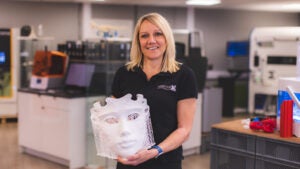As a boutique professional services firm, Interaction Associates helps clients develop leaders, build inclusive teams and improve their meeting cultures with training and proprietary leadership content. In short, Interaction Associates or IA shows companies how to work better together.
The company continuously strives to improve its own operations as well, says Chris Williams, Director of Business Operations. In a move to make its 20 employees and more than 50 consultants more effective, and to improve operations, executives decided to go 100 percent virtual in 2018.
“Our employees dreaded the commute to Boston’s seaport district in downtown,” Williams says. “It was an hour to an-hour-and-a-half on a good day, and we realized employees would be happier and more productive if they didn’t have to commute.” The executive team also realized they could hire nationally without worrying about where a candidate lived or the relocation costs that could be incurred.
But going remote overnight wasn’t a move Interaction Associates could make with its legacy technology platform. It had an old Sage MAS 500 system that ran on an on-premises server and had been heavily customized. While the system functioned on a basic level, the company lacked a backup system and the multiple Sage customizations stymied upgrades. Retrieving actionable business data was extremely difficult. Because the old system wasn’t cloud-ready and IA’s lease ended in 30 days, executives decided to outsource accounting.
Outsourced firm not project based
The outsourced solution lasted seven months. “The arrangement was a difficult one; the system and workflow the outsourced firm was using did not align with our business needs,” Williams says. “They utilized Intacct with a Nexonia Time & Expense Plug in. Because our business is heavily project based, it is critical that our time and expense data integrate directly into a project module.”
Williams discovered the outsourced firm treated IA like a manufacturing firm selling widgets. They did not set IA up with a project module, just a General Ledger. “I realized within the first 30 days, that we didn’t have the right technical set up for our business,” Williams says. “We have different bill rates and different terms and our accounting partner had assumed all our customers were net 30 while we offer 60, 90 and net 120 terms. In addition, the technical staff were based overseas in Bangalore, India; to operate we relied on communication through Google docs, lots of spreadsheets, and were challenged by the time zone barrier.”
The firm used Nexonia because Intacct did not have a mobile friendly app for time and expense. In addition, raw time and expense data – for every one of the accounting firm’s 400+ clients – was pulled once a week into a data warehouse and then pushed to Intacct.
“There wasn’t a clear mapping or structure between project data using a general ledger set up versus Intacct project so putting together client invoices was an absolute nightmare,” Williams says.
“I spent 50 percent of my week reading contracts and informing the support team how to set up our projects in the Intacct system,” he adds. “It was a frustrating situation. The outsourced accounting firm would send our client invoices, but their policy was not to make collection calls, so often customer invoices just sat in a queue.”
Emergency meeting
Williams called an emergency meeting with IA’s CEO and then redeployed half of IA’s sales operations staff to review invoices and make collection calls. In the background, the IA team began looking for a new technology platform so they could bring the accounting function back in-house.
“We got all our stakeholders together in a room for a day,” Williams says. “We walked through our entire workflow and outlined our requirements versus our needs. We worked as a group to bring in important historical context and really assess our minimum requirements – in other words, we practiced what we teach our own clients about the importance of stakeholder involvement, achieving clarity on the level of involvement in decision-making, and ways to reach the desired outcome.”
Armed with a short requirement list, IA hired an independent ERP expert to screen 15 ERP platforms and return a short list of three options. After watching demos of those three options, the stakeholders agreed one platform stood above the rest: Acumatica.
“It was so clear,” Williams says. “The first time I saw the user interface of Acumatica, I knew this was the way to go. I remember looking at Intacct’s user interface and thinking half of the screen was blank, it wasn’t responsive, and I almost needed a magnifying glass just to view the fields.”
 Canada (English)
Canada (English)
 Colombia
Colombia
 Caribbean and Puerto Rico
Caribbean and Puerto Rico
 Ecuador
Ecuador
 India
India
 Indonesia
Indonesia
 Ireland
Ireland
 Malaysia
Malaysia
 Mexico
Mexico
 Panama
Panama
 Peru
Peru
 Philippines
Philippines
 Singapore
Singapore
 South Africa
South Africa
 Sri Lanka
Sri Lanka
 Thailand
Thailand
 United Kingdom
United Kingdom
 United States
United States








